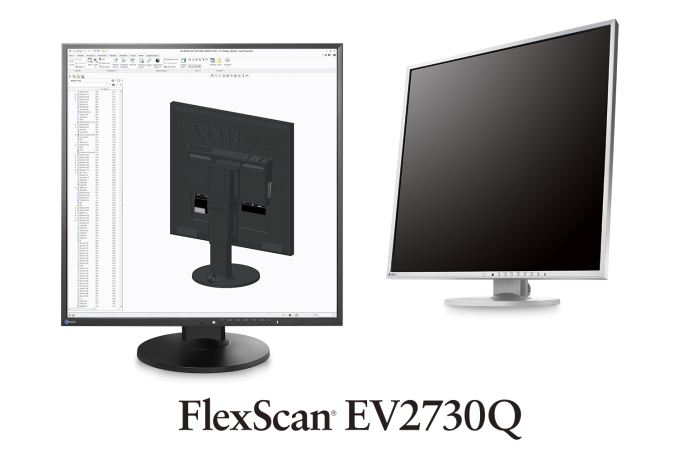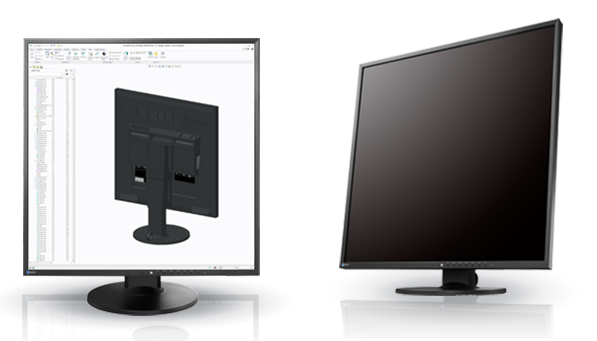EIZO Announces the IPS 26.5” FlexScan EV2730Q Monitor with 1920x1920 Resolution
by Ian Cutress on November 19, 2014 1:18 PM EST
I will be honest, the nearest I think I have come to a square monitor is the 1024x768 panel I use as a tiny second screen on my main computer. When I first saw EIZO’s press release regarding this new 1920x1920 monitor it took me aback, imagining what it might feel like to actually use. The consumer monitor market is expanding to various screen sizes, usually following 16:9, 16:10 or 21:9 for the most part. But after a few minutes, I realized that non-standard monitor sizes are most likely abundant in various industries, such as medical, when they are designed for a specific purpose and quality. So while a 1:1 monitor is something interesting to see in the consumer space, perhaps it might not be so new when considering industrial use scenarios. That all being said, it would be interesting to see this one in the flesh.
1920x1920 means 3.7 megapixels, the same as 2560x1440. This compares to the regular desktop sizes of 1080p (2MP), 1200p (2.3MP), 3200x1800 (5.8MP) and 2160p (8.3MP), which indicates that if this monitor were to be used for gaming, performance would put it directly in the 1440p category. That being said, EIZO is not exactly targeting this monitor for gaming. The more vertical space provided is better suited to writers, coders or CAD who require many items on the screen at once, often side by side. As an editor, I often have an image on one side of my screen while writing my reviews on the other, so I can certainly see this marketing angle.
The basic specification list gives the IPS-based EV2730Q as a 16.8 million color display with 178 degree viewing angles, a 300 nit brightness, a 1000:1 contrast ratio and 5ms gray-to-gray response time. Video inputs are via DisplayPort and a dual-link DVI-D, with a maximum refresh rate of 60 Hz. Two 1W speakers are built in, along with a 2-port USB 2.0 hub. 100mm VESA is supported with 344º of swivel and 35º/5º of tilt. Height is also adjustable.
The button controls are on the front of the panel, and EIZO gives three profiles called sRGB, Movie and Paper along with two user customizable profiles. The Paper profile is designed to reduce the amount of blue in an image to prevent eyestrain while reading or coding against a white background. A feature called Auto Ecoview can detect the ambient light level and adjust the screen’s brightness to reduce eyestrain and power. This can also detect when a user leaves the desk to power down the monitor, with power on when the user returns.
We are contacting EIZO to find what markets the EV2730Q will be sold in as well as the prices. EIZO has announced that the monitor will be available from Q1 in 2015, but this will vary by country. With any luck, it will be on display at CES.
Source: EIZO via TFTCentral
















70 Comments
View All Comments
mapesdhs - Thursday, November 20, 2014 - link
I just wish the wider public was more aware of how industry, govt. & commerce operate,
what they do, the equipment involved, etc. People are staggeringly ignorant of what
makes a nation tick. As tech evolves, everything seems to become increasingly black-box.
As you say, there's often a vast gulf between consumer & industrial tech. Now if only we
had a medium which could be used to explain how stuff works... oh wait. we do, but it's
full of chat shows, soaps & reality junk. I've visited a moderately broad range of industrial
& commercial companies (from power stations to movie companies), always amazes me
the kit they use, how they work, etc.
Btw, I meant to add before, a lot of industrial imaging is greyscale, often with very high bit
depth (eg. 16-bit luminance with 16-bit alpha, ie. instead of 256 shades for each colour
+ alpha as in normal 32bit RGBA, it's 65K shades of grey with 65K alpha levels too).
Particularly true for defense, medical & GIS. Today it's done in a different way though,
typically with 10 or 12bits per channel that are then converted through RGB lookups
to a final greyscale output to relevant monitors. NVIDIA has a couple of relevant PDFs:
http://www.nvidia.co.uk/content/quadro_fx_product_...
http://www.nvidia.co.uk/docs/IO/40049/TB-04701-001...
Still not quite there yet with fully native 48bit RGBA which used to be possible
with old high-end tech, but not far off.
Ian.
lukarak - Thursday, November 20, 2014 - link
This would be great for a cyclops, but i think humans have two eyes side by side so monitors with greater width than height are not all that illogicalcoburn_c - Thursday, November 20, 2014 - link
Sure would make that 4 corner snap thing in Windows 10 useful.MamiyaOtaru - Friday, November 21, 2014 - link
used a 5:4 for a long time (1280*1024) and currently have a 4:3 (1600*1200). Not a fan of increasingly wide screens, but this one does manage to look pretty damn weird even to me. Would be awesome to take to LANs, just for the looksrobin051 - Saturday, November 22, 2014 - link
Seriously, USB2.0?Backbutton - Wednesday, November 26, 2014 - link
I never liked the 16:9, and wish 4:3 was available. It was marketing and cost cutting that pushed the consumer to embrace 16:9--good for watching videos, but not for practical/serious work.I still have my Eizo Nanao 17 inch 4:3 CRT--it is still working perfect, but I need to take it to the dump, no space for it.
I got 2 Samsung 20" 4:3's at 1600 x 1200. When they were discontinued, I bought a Dell 20" 1600 x 1200 to keep as a spare.
When I went on a consulting assignment, I requested that they get me a 20" Dell 1600 x 1200 or I would bring my own, because I wanted the vertical pixels. They said they would get me one, but then said they would get me a Dell 24" 1920 x 1200, rather than the 20" because it was cheaper (with their discount). I did not want one, but they said why not, you get the 1600 x 1200, plus 230 pixels more, so I agreed. I liked the Dell UH2410 1920 x 1200--it was great, after I left the assignment, I bought two of them for myself. And they are what I use now. I keep the three 20" 1600 x 1200 as spares, and don't use them because except for Eizo, no vendor sells such resolution anymore.
I hope the 4:3's and 16:10's make a comeback. The more square screens are more naturally, and suitable. The 16:9 was such a bad idea.
Also would like to see the same in TV's. I am still using my 27 inch Sony TV of 24 year vintage. It is on the blink, and that worries me--no where to obtain a replacement, and difficult to fix. The 4:3 27 inch is much better than a widescreen.
everdark81 - Tuesday, December 2, 2014 - link
It would be interesting to see a 1440x1440 display with a similar height to a typical 27" 2560x1440 monitor for placement on each side.mattlach - Monday, January 19, 2015 - link
With a 21.5" 1920x1080 screen in portrait on either side, this could be the next perfect PLP setup...Can't find this screen for sale anywhere. Anyone know what it costs?
TwoMetreBill - Monday, March 2, 2015 - link
Any availability and pricing info yet? I've searched the web and only found pricing (but not availability) for Sweden at around $1,100 USD.wowlfie - Thursday, November 26, 2015 - link
I really really wish they would make a 34 inch or larger square monitor. I use a 34 inch Benq right now but hate the narrowness of the wide screen profile. A square one negates portrait and landscape and merges them into one. Much better!